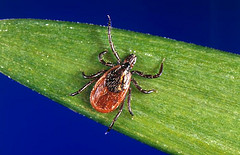
UNIVERSITY PARK – As spring turns Pennsylvania’s fields and forests lush and green — and outdoors enthusiasts turn out to go trout fishing, gobbler hunting, hiking, mountain biking, camping, canoeing and more — they will be greeted by sun and fun and at least one dangerous pest: Blacklegged ticks (commonly called “deer” ticks).
Carriers of the bacteria that cause Lyme disease, they are a lot more common around the state than they used to be, according to an entomologist in Penn State’s College of Agricultural Sciences.
“A decade or so ago, these ticks were rare in many Pennsylvania counties, but unfortunately that has changed dramatically,” said Steven Jacobs, senior extension associate in entomology. “The majority of Pennsylvania counties have populations of blacklegged ticks, and they often carry and spread Lyme disease.”
Lyme disease is a disorder that can cause a variety of symptoms, including a bull’s-eye-like rash, fever, stiff neck, muscle aches and headaches. Left untreated, victims can suffer facial palsy, arthritis and even paralysis. It normally is treated with antibiotics, but if not caught early, recovery can be slow and difficult.
The adult ticks can be active from fall through spring if temperatures remain above 28 F. Ticks in the nymphal (immature) stages are active in May, June and July. Nymphs will attach to mice, chipmunks, birds and other small animals. Adults typically attach to white-tailed deer or other large mammals. While awaiting a suitable host, the ticks usually are found on leaf litter or low branches in brushy, wooded areas.
“The larval and nymphal stages of the tick are no bigger than a pinhead,” warns Jacobs. “Adult ticks are only slightly larger. Research in the eastern United States has shown that ticks most often transmit Lyme disease to humans during the nymphal stages, probably because nymphs are so small they go unnoticed on a person’s body.
“Thus, the nymphs typically have time to feed and transmit the infection — ticks need to feed for 24 to 36 hours to transmit Lyme disease.”
So Jacobs recommends avoiding tick-infested areas such as woods with a high deer population, especially in May, June and July when the nymphs are active. And he urges those who do go afield to take the following precautions when they are going to be in brushy areas:
–Wear light-colored clothing so that ticks can be spotted more easily.
–Tuck pant legs into socks or boots and shirt into pants.
–Spray insect repellent containing DEET on clothes and on exposed skin other than the face, or treat clothes (especially pants, socks and shoes) with permethrin, which kills ticks on contact.
–Wear a hat and a long-sleeved shirt for added protection.
“Also, know the signs of Lyme disease and see your doctor if symptoms develop,” Jacobs said. “If a tick is found attached to a person, it should be removed by carefully grasping the tick with tweezers as close to the skin as possible and pulling straight back with a slow, steady force. Avoid crushing the tick’s body.
“If you want the tick to be identified, place it in a small vial filled with rubbing alcohol and bring it to a county office of Penn State Extension.”
To learn more about blacklegged ticks and Lyme disease, visit the Penn State Entomology Department’s website at http://www.ento.psu.edu/Lyme online.


